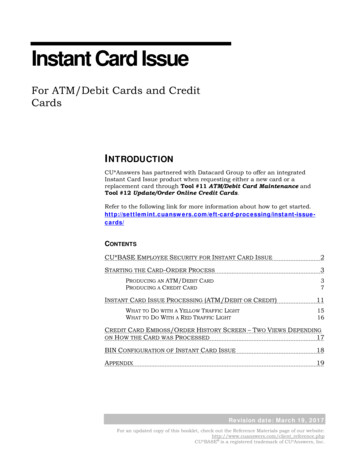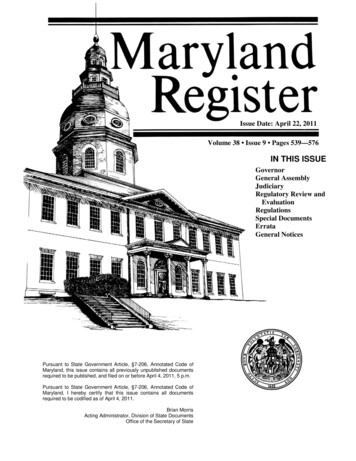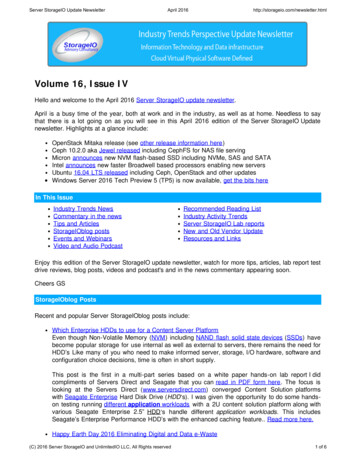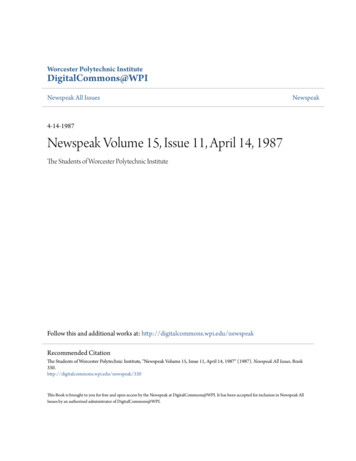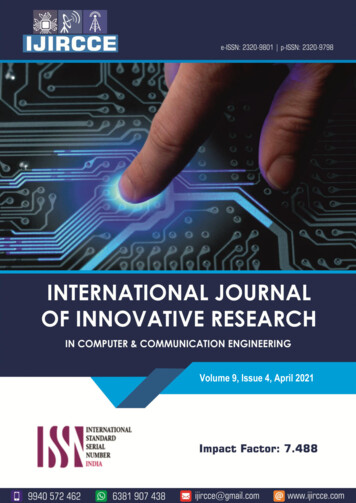
Transcription
Volume 9, Issue 4, April 2021
International Journal of Innovative Research in Computer and Communication Engineering e-ISSN: 2320-9801, p-ISSN: 2320-9798 www.ijircce.com Impact Factor: 7.488 Volume 9, Issue 4, April 2021 DOI: 10.15680/IJIRCCE.2021.0904041 Weather Data Accumulation using ArduinoParth Joshi, Nishit Mistry, Asiya Khan, Harish Motekar, Archana ChauguleB.E Student, Dept. of I.T., Shah & Anchor Kutchhi Engineering College, Mumbai, IndiaB.E Student, Dept. of I.T., Shah & Anchor Kutchhi Engineering College, Mumbai, IndiaB.E Student, Dept. of I.T., Shah & Anchor Kutchhi Engineering College, Mumbai, IndiaAssistant Professor, Dept. of I.T., Shah & Anchor Kutchhi Engineering College, Mumbai, IndiaAssistant Professor, Dept. of I.T., Shah & Anchor Kutchhi Engineering College, Mumbai, IndiaABSTRACT: Weather data accumulation plays a very vital role in understanding the varying weather patterns. Thischanging weather condition affects the country and people financially. Determining weather is a difficult andchallenging task. Weather forecasting is used for determining future weather conditions based on current and pastweather data. This data is collected and after applying various machine learning techniques provided strategicinformation. The accumulation of data is done with the help of sensors. This paper describes various techniques tocollect the weather data with the help of electronic systems, process the data, and send it to the centralized andsecure data storage.KEYWORDS:Weather monitoring, Electronic sensing, Centralized data storage, Wireless data transfer, Internet ofThings, Correlated weather parameters, data cleaning.I. INTRODUCTIONData collection in any country is done by their Meteorological department and this data then can be usedfor various specialized purposes. To perform the analysis on that data, the data needs to be bought which may proveto be costly. [1] Also, there is a need for continuous data collection with the perseverance of past data. [6] Today,IoT has made the traditional objects not only smart but also has opened the doors for a wide range of applications.Now, further advancement has been made in this field with the introduction of IoE which makes the process moreautomated. So the need for continuous monitoring becomes minimal and in many cases even negligible.This paper discusses the approach of IoT to build an electronic system for weather data collection. Thissystem will be based on the Arduino platform and coded in embedded C using its Ide. Arduino is an open-sourceplatform with real-time usage. Today, we have many sensors which help us to perceive the data of the environmentand convert into numerical form and use it to perform various functions. The project discussed in this paper uses aTemperature and Humidity sensor namely DHT11, a Gas Sensor namely MQ7, and a Pressure sensor MPX10DP.All these sensors serve various purposes to complete the weather data collection.a. Problem FormulationFormulation of Problem plays an important role in determining the purpose, requirement, and usage of theproject that is made.So the problem statement of this project can be formulated as, Creation of the IoT based electronic systemwith the help of Arduino based microcontroller board for the collection of weather data in a given environment. Thissystem uses different electronic sensors for data accumulation.IJIRCCE 2021 An ISO 9001:2008 Certified Journal 1880
International Journal of Innovative Research in Computer and Communication Engineering e-ISSN: 2320-9801, p-ISSN: 2320-9798 www.ijircce.com Impact Factor: 7.488 Volume 9, Issue 4, April 2021 DOI: 10.15680/IJIRCCE.2021.0904041 II. LITERATURE SURVEYa.Design of Weather Monitoring System and Smart Home AutomationAutomated systems can be created by using the weather data as input to control the home devices. Weather data iscollected through various sensors i.e. DHT-11 for temperature and humidity, LDR for light, BMP180 foratmospheric pressure, and LPG gas sensor. The automation achieved through weather sensing involved temperature,light, and water heater control. This system also helps to avoid hazardous situations that could occur due to leakageof gas. It opens the door of the windows as soon as the gas leakage is detected. The system also targets the usagethrough smartphones and a voice assistance approach for disabled people. [1]b.Weather Monitoring System using IOT with Arduino Ethernet ShieldSensors generate lots of data that it senses through the environment and storing that data requires lots of storagespace. So using Cloud to store the data and then accessing and displaying the monitored parameter on the web pageproves to be beneficial. Arduino Ethernet shield allows the Arduino Uno board to wirelessly share data through theinternet. It also has an on-chip micro-SD card slot for storing the data. The sensing of Temperature and humidity isdone with the help of the DH11 sensor and rainwater is detected with the help of the rain sensor. This system aims toreduce the manual data collection and introduce some automation in the process. [5]c.Implementation of Weather Monitoring SystemWeather monitoring proves to be an important step for weather forecasting. This study explains the alreadyimplemented weather station in Sri Lanka and suggests the extension with the implementation of a modular weatherstation with the support for wireless transmission and reception of data. It also explains various weather sensingmodules and their usage. The system is implemented on the Arduino Uno microcontroller board and allows thesensing temperature and humidity through the DHT11 sensor. This work also suggests further extension by theintroduction of the device controlling through a change in sensor reading. [3]III. HARDWARE REQUIREMENTSThis section discusses the various components required to make this project.Sr No.Sensor Names1.IJIRCCE 2021DHT11DescriptionHumidity & Temperature Sensor2.MQ-7CO Gas Sensor3.MPX10DPPressure Sensor4.Arduino Uno BoardMicro-Controller Board5.ESP8266 NodeMCUWi-Fi Module An ISO 9001:2008 Certified Journal 1881
International Journal of Innovative Research in Computer and Communication Engineering e-ISSN: 2320-9801, p-ISSN: 2320-9798 www.ijircce.com Impact Factor: 7.488 Volume 9, Issue 4, April 2021 DOI: 10.15680/IJIRCCE.2021.0904041 1. DHT-11 - Humidity & Temperature SensorDHT11 is a low-cost temperature and humidity sensor that gives us a perusing of the encompassingtemperature & humidity.Specifications:a.b.c.d.Operating Voltage: 3.5V to 5.5VOperating current: 0.3mA (measuring) 60uA (standby)Temperature Range: 0 C to 50 CHumidity range: 20% to 80%Fig 1: DHT11 Pinout[9] This sensor serves as the collector of Temperature and Humidity data from its sensing environment. Ithas an inbuilt thermistor for sensing the temperature and a humidity sensor for sensing the humidity. The reading ofhumidity is relative humidity measured in percentage and temperature is in the format of degree Celsius.2. MQ-7 CO Gas SensorThe MQ7 sensor senses the Carbon Monoxide concentration in the air. The affectability for the sensor ishigh and has a high reaction time.Specifications:a. Operating Voltage: 1.5V to 5Vb. Operating current: 150 mAc. Detection Range: 10ppm to 1000ppmCO is a dull, dry, scentless, ignitable gas. It very well might be noxious which might be lethal to humanwellbeing that has additionally been found in a few nations.Fig 2: MQ-7 CO Gas sensorIt is equipped for identifying the measure of CO gas in the scope of 20 to 2000 ppm.3. MPX10DP - Pressure SensorThe MPX10DP is a Pressure Sensor for showing the natural changes in pressure. [4] It furnishes us withpractically precise outcomes and the reaction time is likewise acceptable separated from the smallest deferral hereand there.IJIRCCE 2021 An ISO 9001:2008 Certified Journal 1882
International Journal of Innovative Research in Computer and Communication Engineering e-ISSN: 2320-9801, p-ISSN: 2320-9798 www.ijircce.com Impact Factor: 7.488 Volume 9, Issue 4, April 2021 DOI: 10.15680/IJIRCCE.2021.0904041 Specifications:a. Operating Voltage: 3V to 6Vb. Operating current: 6mAc. Detection range: 0KPa tp 10KPad. Pressure Type: DifferentialFig 3: MPX10DP Pressure SensorThe yield given by the sensor is straightforwardly corresponding to the applied pressing factor.IV. METHODOLOGYThis section will describe the methodology & approach taken for the weather data accumulation system.A. Setup of Working EnvironmentWe have performed our experiment on the micro-controller board named Arduino Uno. [3] It is based onthe Atmega328P microchip having 14 Digital pins and 6 Analog pins. The operating voltage for this board is 5V.Fig 4: Arduino Uno board with Atmega328P Chipset[2] Arduino provides an integrated environment for programming the microcontroller board. This IDEprovides an abstraction from the programming of hardware with assembly-level programming. [5] Arduino IDEallows the programmer to compose the code in Embedded C with the support of easy-to-use libraries for the manyhardware components.B. Connecting to cloudOne of the important steps in the data accumulation process is the storage of data. This storage of dataallows us to perform further steps of analysis. To connect the system to the cloud, we need a Wi-Fi module for thesystem. Arduino Uno doesn’t come with the inbuiltWi-Fi module. So we included an ESP8266 incorporatedmicrocontroller board named NodeMCU.IJIRCCE 2021 An ISO 9001:2008 Certified Journal 1883
International Journal of Innovative Research in Computer and Communication Engineering e-ISSN: 2320-9801, p-ISSN: 2320-9798 www.ijircce.com Impact Factor: 7.488 Volume 9, Issue 4, April 2021 DOI: 10.15680/IJIRCCE.2021.0904041 Fig 5: ESP8266 NodeMCUIt is planned particularly for IoT-based applications and it incorporates firmware that suddenly spikes indemand for ESP8266 Wi-Fi Soc from Espressif Frameworks.C. Importance of Sensing the EnvironmentThe sensors are responsible to percept their environment and gather the data for which it is built.MPX10DP is a temperature and humidity sensor that helps to gather real-time change in temperature and humiditydata. [10] Both the Temperature and humidity are inter-connected and change in one affects the other. An increasein temperature decreases the humidity and as temperature decreases humidity level increases and reaches the dewpoint when its relative level is 100 percent. [11] At dew level, the air around us is saturated with water vapor i.e.more water is in the gaseous state in the environment. High humidity also introduces some concerns. So measuringthe real-time value of temperature and humidity is important for studying the weather.MQ-7 CO is a carbon monoxide sensor that collects the CO concentration in the environment. [7] CarbonMonoxide is a toxic gas which directly affects the human. High concentration in the environment can disrupt thetransport of blood which leads to heart problems. Its presence also encourages greenhouse gases to stay in theenvironment. So Carbon monoxide doesn’t directly affect the weather, but measuring its concentration can help toreduce various issue caused by its presence,MPX10DP is a pressure sensor that measures the Atmospheric pressure in KPa. [8] Atmospheric pressureis affected directly by altitude. Pressure decreases as the altitude increases. Decreased air pressure affects the oxygenconcentration in the environment. The movement of low atmospheric pressure in an environment makes the weathercloudy, windy and increases the chance of precipitation. So sensing the environment helps to a greater extent tounderstand the change in weather, effect on humans and the environment.D. Project WorkflowFig 6: Workflow of the systemIJIRCCE 2021 An ISO 9001:2008 Certified Journal 1884
International Journal of Innovative Research in Computer and Communication Engineering e-ISSN: 2320-9801, p-ISSN: 2320-9798 www.ijircce.com Impact Factor: 7.488 Volume 9, Issue 4, April 2021 DOI: 10.15680/IJIRCCE.2021.0904041 Fig 6. Discusses the flow of data in the system among various components. The data about the environmentis collected by the three sensors i.e. MPX10DP, MQ7 CO, DHT11. The collected data is about the temperature,humidity Carbon monoxide concentration, and Atmospheric pressure. This data is processed by the microcontrollerboard and is then forward to the cloud with the help of NodeMCU for storage. Storage of data is an important step inthis process, as the data then can be fetched and after applying various analysis algorithms can generate conclusivereports.E. Using Data for analysisThe data collected through the sensors and stored in the cloud can be used to analyze it and induce someconclusive reports. The data first needs to be cleaned. To make the data more comprehensive, we can introducesome gaps in the data collection stage as continuous data can use up all the storage. Cleaning of data makes sure thatthe data is properly formatted and there is no incomplete data as well as corrupted data. After the process iscompleted the data is fed into the Machine learning algorithm and is checked against various algorithms and the onewith maximum accuracy is selected. Thus this helps to perform the task of forecasting the weather based on theprevious data as well as the newly generated data. The graphical charts and diagram can also be generated whichhelps to generate interactive and easy to interpret reports.V. CIRCUIT DIAGRAMTo visualize the working of an electronic project, creating a circuit diagram is an important step. It showsvarious circuit-level detailsFig 7: Circuit Diagrama. The associations are easy to the interface where the sensors are associated with the Vcc, GND, and their separatesimple or advanced information pins.b. The undertaking can be executed for industries, family applications which empowers us to screen the climate.c. The utilization of the Wi-Fi module is to empower an entire universe of plausibility when we send the information tosome cloud administration like Amazon Web Administrations (AWS), Google Cloud, ThingSpeak, and so on.d. The investigation of information should be possible to foresee future examples of climate or learn experiences thatcould help anybody and everybody during troublesome occasions.IJIRCCE 2021 An ISO 9001:2008 Certified Journal 1885
International Journal of Innovative Research in Computer and Communication Engineering e-ISSN: 2320-9801, p-ISSN: 2320-9798 www.ijircce.com Impact Factor: 7.488 Volume 9, Issue 4, April 2021 DOI: 10.15680/IJIRCCE.2021.0904041 VI. SOME COMMON MISTAKES The sensor associations are practically clear as they, for the most part, have advanced or simple pins with aVcc and GND association which is quite straightforward.Utilize long wires and associate each wire appropriately with the pins of sensors and microcontroller board bystudying the datasheet and circuit diagram.Ensure none of the wires are taken out in a rush and every wire is associated with your right terminals.VII. FUTURE SCOPE This system along with the integration of machine learning algorithms for forecasting can be used in agriculture forthe farmers to have a standalone system specialized for their farms.More specialized and sensitive sensors which can collect the data of the slightest change in the environmentcan be used to make the system less prone to errors.To increase the interactivity of the users with this system, a user-friendly mobile or web-based application willbe a prominent step in the success of this project.VIII. CONCLUSIONWeather data collection and storage is an important step to achieve the final step of weather forecasting.Selecting sensors with proper specification helps to achieve accurate sensing and accurate sensing leads to moreprominent reports. Cloud storage helps to provide a robust and efficient data storage platform. Electronic systemwith less human intervention is what is achieved through the imminent field of IoT. This helps to build theprediction model through the use of various algorithms whose input requirement is satisfied by this data collectionelectronic model.IX. ACKNOWLEDGEMENT Mr. Harish Motekar, thank you for rousing us in the practical’s just as the talks for suspecting better for our IoEquestions and Task.Miss Archana Chaugule, saying thanks to you for assisting us with any inquiries and questions identified withthe IoE Task.SAKEC Faculty, Thank you for giving us the Digital Library stage to assist us with everything withoutexception about any point. [3]REFERENCES1.2.3.4.5.6.Indrasom Majumdar, Bikram Banerjee, Mutyala Tara Preeth, Dr. Malaya Kumar Hota, Design of WeatherMonitoring System and Smart Home Automation, School of Electronics Engineering (SENSE).Karthik Krishnamurthi, Suraj Thapa, Lokesh Kothari, Arun Prakash, Arduino Based Weather Monitoring System,International Journal of Engineering Research and General Science Volume 3, Issue 2, March-April, 2015.KiranmaiNandagiri and Jhansi Rani Mettu, Implementation of Weather Monitoring System, International Journal ofPure and Applied Mathematics, Volume 118 No. 16 2018, 477-493.Jitendra Singh, Rehan Mohammed, MradulKankaria, Roshan Panchal, Sachin Singh, Rahul Sharma, Arduino BasedWeather Monitoring System, International Journal of Advanced in Management, Technology and EngineeringSciences Volume 8, Issue III, MARCH/2018, ISSN NO : 2249-7455.V. Nivedan, Dr. R. Kannusamy, Weather Monitoring System using IoT with Arduino Ethernet Shield, InternationalJournal for Research in Applied Science & Engineering Technology (IJRASET), Volume 7 Issue I, Jan 2019.Ejodamen Pius Uagbae, Ekong, Victor Eshiet, Inyang, Udoinyang Godwin, Arduino-Based Weather MonitoringSystem, SMART-SMART-iSTEAMS Multidisciplinary Conference Ogwashi-uku, Delta State, Nigeria, February2018.IJIRCCE 2021 An ISO 9001:2008 Certified Journal 1886
International Journal of Innovative Research in Computer and Communication Engineering e-ISSN: 2320-9801, p-ISSN: 2320-9798 www.ijircce.com Impact Factor: 7.488 Volume 9, Issue 4, April 2021 DOI: 10.15680/IJIRCCE.2021.0904041 ssure/Krishnamurthi, Karthik, et al. "Arduino based weather monitoring system." International Journal of EngineeringResearch and General Science 3.2 (2015): 452-458.10. related-7245642.html11. t.htmlIJIRCCE 2021 An ISO 9001:2008 Certified Journal 1887
a. Design of Weather Monitoring System and Smart Home Autom ation Automated systems can be created by using the weathe r data as input to control the home devices. Weather d ata is collected through various sensors i.e. DHT-11 for tempera ture and humidity, LDR for light, BMP180 for atmospheric pressure, and LPG gas sensor. The automatio n .







